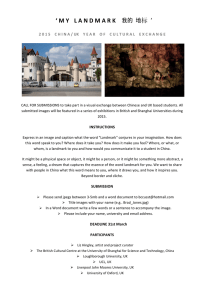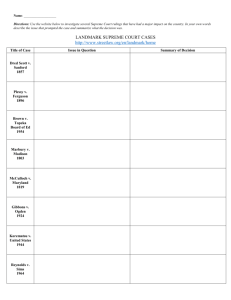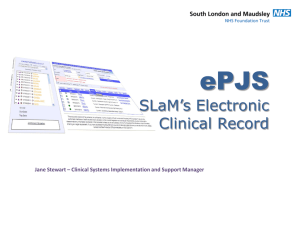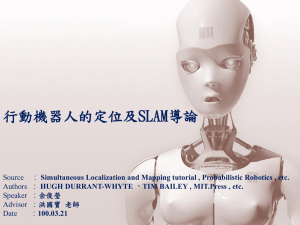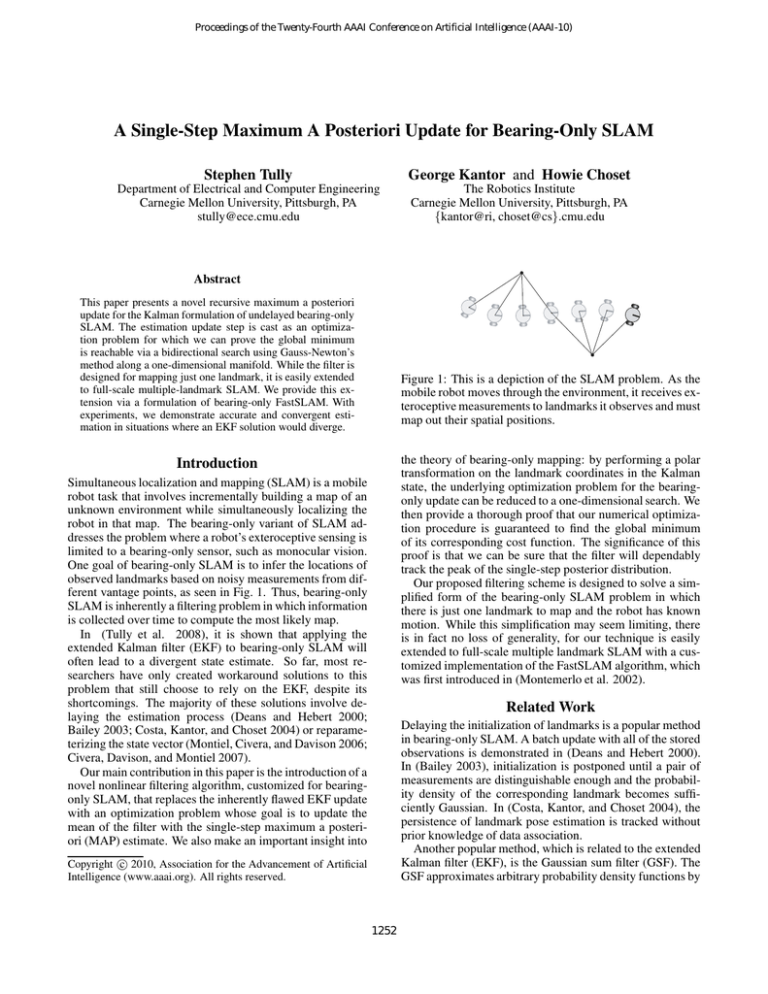
Proceedings of the Twenty-Fourth AAAI Conference on Artificial Intelligence (AAAI-10)
A Single-Step Maximum A Posteriori Update for Bearing-Only SLAM
Stephen Tully
George Kantor and Howie Choset
Department of Electrical and Computer Engineering
Carnegie Mellon University, Pittsburgh, PA
stully@ece.cmu.edu
The Robotics Institute
Carnegie Mellon University, Pittsburgh, PA
{kantor@ri, choset@cs}.cmu.edu
Abstract
This paper presents a novel recursive maximum a posteriori
update for the Kalman formulation of undelayed bearing-only
SLAM. The estimation update step is cast as an optimization problem for which we can prove the global minimum
is reachable via a bidirectional search using Gauss-Newton’s
method along a one-dimensional manifold. While the filter is
designed for mapping just one landmark, it is easily extended
to full-scale multiple-landmark SLAM. We provide this extension via a formulation of bearing-only FastSLAM. With
experiments, we demonstrate accurate and convergent estimation in situations where an EKF solution would diverge.
Figure 1: This is a depiction of the SLAM problem. As the
mobile robot moves through the environment, it receives exteroceptive measurements to landmarks it observes and must
map out their spatial positions.
the theory of bearing-only mapping: by performing a polar
transformation on the landmark coordinates in the Kalman
state, the underlying optimization problem for the bearingonly update can be reduced to a one-dimensional search. We
then provide a thorough proof that our numerical optimization procedure is guaranteed to find the global minimum
of its corresponding cost function. The significance of this
proof is that we can be sure that the filter will dependably
track the peak of the single-step posterior distribution.
Our proposed filtering scheme is designed to solve a simplified form of the bearing-only SLAM problem in which
there is just one landmark to map and the robot has known
motion. While this simplification may seem limiting, there
is in fact no loss of generality, for our technique is easily
extended to full-scale multiple landmark SLAM with a customized implementation of the FastSLAM algorithm, which
was first introduced in (Montemerlo et al. 2002).
Introduction
Simultaneous localization and mapping (SLAM) is a mobile
robot task that involves incrementally building a map of an
unknown environment while simultaneously localizing the
robot in that map. The bearing-only variant of SLAM addresses the problem where a robot’s exteroceptive sensing is
limited to a bearing-only sensor, such as monocular vision.
One goal of bearing-only SLAM is to infer the locations of
observed landmarks based on noisy measurements from different vantage points, as seen in Fig. 1. Thus, bearing-only
SLAM is inherently a filtering problem in which information
is collected over time to compute the most likely map.
In (Tully et al. 2008), it is shown that applying the
extended Kalman filter (EKF) to bearing-only SLAM will
often lead to a divergent state estimate. So far, most researchers have only created workaround solutions to this
problem that still choose to rely on the EKF, despite its
shortcomings. The majority of these solutions involve delaying the estimation process (Deans and Hebert 2000;
Bailey 2003; Costa, Kantor, and Choset 2004) or reparameterizing the state vector (Montiel, Civera, and Davison 2006;
Civera, Davison, and Montiel 2007).
Our main contribution in this paper is the introduction of a
novel nonlinear filtering algorithm, customized for bearingonly SLAM, that replaces the inherently flawed EKF update
with an optimization problem whose goal is to update the
mean of the filter with the single-step maximum a posteriori (MAP) estimate. We also make an important insight into
Related Work
Delaying the initialization of landmarks is a popular method
in bearing-only SLAM. A batch update with all of the stored
observations is demonstrated in (Deans and Hebert 2000).
In (Bailey 2003), initialization is postponed until a pair of
measurements are distinguishable enough and the probability density of the corresponding landmark becomes sufficiently Gaussian. In (Costa, Kantor, and Choset 2004), the
persistence of landmark pose estimation is tracked without
prior knowledge of data association.
Another popular method, which is related to the extended
Kalman filter (EKF), is the Gaussian sum filter (GSF). The
GSF approximates arbitrary probability density functions by
c 2010, Association for the Advancement of Artificial
Copyright Intelligence (www.aaai.org). All rights reserved.
1252
a weighted combination of many multivariate Gaussians.
Since the GSF requires maintaining a large set of EKFs,
its computational complexity can become problematic when
a large number of landmarks are initialized simultaneously.
An approximated Gaussian sum method is proposed in (Solà
et al. 2005), where a set of parametrized cascaded Gaussian
distributions is managed and updated by federated information sharing (FIS). Although this method is an improvement
over the standard GSF, a larger state is still required to initialize landmarks.
Particle Filters (PFs), which incorporate non-Gaussian
distributions, are widely used in SLAM research. In (Kwok
and Rad 2006), particle filters are adopted for bearing measurements by associating hypothesized pseudo-ranges with
each measurement and by implementing a re-sampling procedure to eliminate improbable particles. In (Davison 2003),
a set of particles are maintained along the viewing ray of a
landmark and initialization is delayed until the range distribution is roughly Gaussian. In (Eade and Drummond
2006), a FastSLAM particle filter is used for monocular
SLAM with a partial initialization strategy that estimates the
inverse-depth of new landmarks rather than depth. Unfortunately, particle filter methods often require a large number
of particles for initialization.
Direct parametrization of inverse-depth is used for
monocular SLAM in (Montiel, Civera, and Davison 2006)
and a method of inverse-depth and depth conversion is proposed by the same authors in (Civera, Davison, and Montiel
2007). It is well known that the inverse-depth representation
can handle distant landmarks more efficiently than conventional parameterizations because it incorporates a measurement equation with low linearization error. Unfortunately,
though, this method is still susceptible to a diverging state,
which we show in our experiments.
Figure 2: For the simplified bearing-only update problem,
the robot is located on the origin, the prior distribution for
the landmark is shown with a gray ellipse, and a bearing
measurement zk is shown as a ray emanating from the robot.
the new covariance Pk for our landmark distribution given
the information provided by the sensor measurement.
MAP Simplified Bearing-Only Update Filter
A popular method for updating the mean and covariance is
to adopt the well known extended Kalman filter (EKF) equations, which is used for SLAM in (Dissanayake et al. 2001).
But in (Tully et al. 2008), it is shown that for bearing-only
SLAM, the EKF update can lead to unrecoverable divergence of the state estimate. This can be attributed to the
nonlinearity of the measurement function and the deficiency
of the EKF.
In this section, we will introduce a new filter update step
that is specific to the simplified bearing-only update problem
and that will be used in place of the EKF update.
SLAM as an Optimization Problem
We argue that a more sophisticated solution than the EKF
would be to update the mean of the landmark distribution
with the single-step maximum a posteriori (MAP) estimate.
This represents the peak of the posterior distribution defined
for the most recent measurement and, in our opinion, a better guess at the new mean. By definition, the solution is as
follows,
X̂kl = arg max fz (zk |X)fX (X)
Simplified Bearing-Only Update Problem
Before introducing our full-scale SLAM solution, we will
first analyze a simplified form of bearing-only SLAM, which
we will refer to as the simplified bearing-only update problem, see Fig. 2. Although this formulation is contrived by
design, the forthcoming analysis is a prerequisite to our
more general full-scale SLAM solution.
For the simplified bearing-only update problem, we assume the pose of the robot Xkr at time step k is known and
therefore not included in the state. The robot is mapping
just one landmark with a bearing sensor and has a prior esl
timate of the landmark location: its mean X̂k−1
and covariance Pk−1 . To simplify the problem even further, we assume
the following convenient initial values,
#
" r # "
l
0
xk
x̂k−1
1
l
r
r
.
=
=
Xk = yk = 0 , X̂k−1
l
0
ŷk−1
0
θkr
X
where fz is the density function that defines the probability of measuring zk when the landmark is positioned at
X = [ x y ]T and fX is the density function that corresponds to the prior distribution for the landmark location
from the previous time step.
When assuming Gaussian models, solving for the singlestep MAP estimate for the simplified bearing-only update
problem is equivalent to finding, via optimization, the global
minimum over x and y of the following cost function,
T
(zk − h(X))2
x−1
−1 x − 1
+
Pk−1
(1)
C1 (X) =
y
y
σz2
Thus, the robot is sitting at the origin with an estimate that
places the landmark on the x-axis one meter away.
We assume the robot obtains, at time step k, a noisy bearing measurement zk to the landmark. The task that we need
to solve is how to properly compute the new mean X̂kl and
X̂kl
=
arg min C1 (X).
X
where h(X) is the measurement function,
h = atan2 (y − ykr , x − xrk ) = atan2 (y, x) .
1253
In addition to updating the mean via the optimization of
Eq. 1, we must compute an update to the covariance matrix
for our landmark estimate. We believe that the conventional
EKF covariance update, while just an approximation to the
true covariance due to linearization, is sufficient in this context and performs well in our experiments,
−1
Pk = Pk−1 − Pk−1 H T HPk−1 H T + σz2
HPk−1 , (2)
where H is the Jacobian of the measurement function, which
we evaluate at the updated mean location X̂kl .
Figure 3: Possible solutions for the landmark mean update
lie on the (red) ellipse.
Reparameterization
As discussed above, we need to find the global minimum of
Eq. 1 in order to find the MAP-optimal state for the simplified bearing-only update problem, which will then become
the new mean for our filter (rather than using the flawed EKF
equations). But if one were to numerically optimize Eq. 1, it
is unclear whether the converged solution would be a local
minimum or if it would be the desired global minimum.
Instead, we will perform a polar transformation to obtain
a cost function that is easier to analyze. Let us define φ and
r as the angle and range to the updated landmark mean,
φ =
r
=
location. Thus, by optimizing over φ in Eq. 7, we are effectively searching over a one-dimensional manifold in the
space of possible updated landmark positions. This manifold is shown in Fig. 3.
Our resulting filter can be summarized by the following
algorithmic steps: find the global minimum of Eq. 7 with respect to φ, compute the optimal range rφ∗ with Eq. 6, reverse
the polar transformation in Eqs. 3 and 4 to obtain the maximum a posteriori x and y coordinates to replace the landmark mean, and lastly update the covariance using Eq. 2.
atan2 (y − ykr , x − xrk ) = atan2 (y, x)
(3)
q
p
r
r
(y − yk )2 + (x − xk )2 = y 2 + x2 , (4)
Cost Function Minimization
and let us impose the constraints −π < φ ≤ π and r ≥ 0 to
ensure that the transformation is one-to-one.
Thus, instead of optimizing over x and y, we can optimize
over φ and r and then undo the polar transformation1. The
cost function in Eq. 1 can now be rewritten in terms of φ and
r as follows,
So far, we have introduced the simplified bearing-only update problem along with a filtering scheme that aims to update the landmark mean via the optimization of Eq. 7. In this
section, we will provide a proof that we can always find the
global minimum of Eq. 7 with numerical optimization.
Global Optimality
2
(z − φ)
T −1
+ [Wφ r − d] Pk−1
[Wφ r − d] (5)
σz2
cos φ
1
=
d=
.
sin φ
0
C2 (φ, r) =
Wφ
First, we must define bounds that will become useful when
analyzing the optimization of the reduced cost function.
φM IN = atan2 (−α , ρβ)
φM AX = atan2 (−α , ρβ) + π,
where α, β, and ρ are parameters in the pre-update covariance matrix, as follows,
2
α
ραβ
Pk−1 =
.
ραβ β 2
Interestingly, there is an analytically optimal solution for
r, as a function of φ, that minimizes Eq. 5 and obeys the
imposed positivity constraint,
−1 T −1
−1
rφ∗ = max WφT Pk−1
Wφ
Wφ Pk−1 d , 0 . (6)
The following conservative assumption is necessary for
the forthcoming proof.
Assumption 1. The bearing measurement zk is assumed to
be in the range φM IN < zk < φM AX with zk 6= 0.
The portion of the polar space that is outside of this range
can be seen in Fig. 3 as the gray shaded area and is defined
as the region for which the optimal range value rφ∗ (Eq. 6)
equates to zero. For any measurement in this region, the
corresponding bearing ray would point away from the prior
landmark uncertainty ellipse. We believe Assumption 1 is
valid because receiving such a measurement is unlikely and
can only be explained by an incorrect association or an unmodeled disturbance. In our implementation, we simply enforce this assumption by discarding measurements outside
of the defined bounds.
We can plug this solution back into Eq. 5 to obtain a reduced
cost function to optimize, which is now a function of only
one variable (the angle φ to the updated landmark mean),
( (z−φ)2
rφ∗ = 0
+ σx2 ,
σz2
C3 (φ) =
(7)
2
(z−φ)
+ dT Λφ d ,
otherwise
σz2
−1 T −1
−1
−1
−1
Λφ = Pk−1
− Pk−1
Wφ WφT Pk−1
Wφ
Wφ Pk−1 .
For every φ value to consider in Eq. 7, there is an optimal r value and therefore a corresponding x and y landmark
1
One might ask why we would not choose to use a polar representation in the first place when parameterizing the landmark. The
reason is that the representation of uncertainty would be different
and the forthcoming derivations would not be possible.
1254
Figure 4: In (a) and (b), two examples are shown in which the derivative of the reduced cost function has three roots. The cost
function would then have two minima as in (c).
We also assume zk is unequal to zero. A bearing of zero
for the simplified bearing-only update problem means that
the measurement completely agrees with the prior estimate
and thus updating the filter is unnecessary. In our implementation, we simply skip the update step in this case.
The next few lemmas will be important for proving that
our optimization converges to the global minimum and
tracks the peak of the posterior distribution.
The result of Lemma 1 is that we need only optimize a
portion of the manifold, shown in Fig. 5, that corresponds to
φ between 0 and zk . The global minimum must lie in this
region.
Lemma 1. The global minimum of the reduced cost function
given in Eq. 7 must lie between φ = 0 and φ = zk .
Proof. For positive zk , Eq. 8 evaluated at 0 is negative and
Eq. 8 evaluated at zk is positive. For negative zk , Eq. 8
evaluated at 0 is positive and Eq. 8 evaluated at zk is negative.
Lemma 2. C3 (φ) is decreasing at φ = 0 in the direction of
φ = zk , and C3 (φ) is decreasing at φ = zk in the direction
of φ = 0.
Proof. First, the global minimum of Eq. 7 must lie between
φ = φM IN and φ = φM AX inclusive. To see this, we point
out that the optimal range (Eq. 6) for all φ outside of these
bounds will evaluate to 0 and therefore Eq. 7 will produce a
cost greater than the corresponding costs for both φM IN and
φM AX . Second, the derivative of Eq. 7 is as follows,
∂C3 (φ)
∂φ
=
a(φ)
=
b(φ) =
τ (φ)
=
a(φ) + b(φ)
Lemma 3. There are at most 2 minima of the reduced cost
function given in Eq. 7 between φ = 0 and φ = zk .
Proof. In Fig. 4 (a) and (b), we show two example cases for
a(φ) and for −b(φ), which are the terms in Eq. 8. Any intersection of a(φ) and −b(φ) drives Eq. 8 to zero which implies
an extremum in the reduced cost function (Eq. 7). We also
note that there are at most two zeros of the second derivative
of a(φ) in the range φ = 0 to φ = φM AX . There is also a
constraint that a(φ) has to be positive for φ = zk . These
two facts restrict the number of times the function a(φ) can
cross over the line defined by −b(φ) between φ = 0 and
φ = zk to at most three, see Fig. 4 (a) and (b) for examples.
At most three intersections implies at most three extrema of
the reduced cost function in the range φ = 0 to φ = zk , two
of which must be minima (based on Lemma 2 and as seen in
Fig. 4 (c)). It is therefore impossible to have more than two
minima in the range 0 to zk . The same argument is valid in
the case of zk < 0.
(8)
8α2 β 2 (1 − ρ2 ) sin(φ)τ (φ)
(α2+β 2+(α2−β 2 ) cos(2φ)+2ραβ sin(2φ))2
−2(z − φ)
σz2
α2 cos(φ) + ραβ sin(φ).
Zeros of Eq. 8 correspond to extrema in the cost function.
For positive zk and zk < φ ≤ φM AX , Eq. 8 is strictly positive, though. For positive zk and φM IN ≤ φ < 0, Eq. 8 is
strictly negative. Thus, there can be no optima outside of the
range φ = 0 to φ = zk . The same argument is valid in the
case of zk < 0.
Optimization Procedure
The objective is to find the global minimum of Eq. 7 in order
to replace the mean of the filter with the MAP estimate.
According to Lemma 1, the global minimum must lie between φ = 0 and φ = zk . According to Lemma 3, there are
at most two minima in that range, one of which is the desired
global minima. This means that a bidirectional search with a
numerical optimization algorithm, such as Gauss Newton’s
method, will find both minima. We start one search from
φ = 0 and another search from φ = zk . The searches are
guaranteed to “fall” into the two minima in the desired range
because of Lemma 2. See Fig. 4 (c) for a depiction of the
optimization procedure.
After running both searches until convergence, the result
with the lower cost (Eq. 7) is the desired global minimum.
Figure 5: Possible solutions for the landmark mean update
lie on the (red) curve.
1255
We use this MAP-optimal φ value to then compute the optimal x and y updated landmark coordinates, which become
the new mean for the filter.
Bearing-Only FastSLAM
In the previous two sections, we have thoroughly explored
a novel nonlinear filtering method to solve the simplified
bearing-only update problem. We also have proven that
the algorithm is guaranteed to replace the mean of the filter
with the maximum a posteriori estimate. But the simplified
bearing-only update problem is limited by several assumptions, e.g. the robot position must be on the origin and the
previous estimate must lie on the x-axis.
To relax these assumptions, we adopt a FastSLAM approach, which was introduced in (Montemerlo et al. 2002).
FastSLAM factors the problem by using a rao-blackwellized
particle filter to estimate the map and the pose.
For each particle in the filter, a candidate map is estimated. And because each candidate map is estimated given
the trajectory of the robot, each landmark estimate is independent. This means we can perform a measurement update to a single landmark without considering correlations
between any of the landmarks. Lastly, when the robot measures a landmark, we can simply rotate, translate, and scale
the coordinate frame accordingly so that the FastSLAM
landmark update fits the form we presented for the simplified
bearing-only update problem, see Fig. 6. Also, any heading
offset we need to subtract to fit the correct form can be added
to the relative measurement zk . After solving for the MAPoptimal estimate, we can reverse the transformation for the
solution, back to the coordinate frame for the particle.
Therefore, FastSLAM is a way to take the optimality of
our novel nonlinear optimization method and apply it to
multiple landmark SLAM with motion uncertainty. This is
done without breaking any of the original assumptions.
Figure 7: This is an experiment based on a subset of the Victoria Park dataset (Guivant, Nieto, and Nebot ). The landmarks depicted with triangles are the range/bearing result.
The dots are the result of our proposed filter. The partial
map (upper left of image) shows the inverse-depth result.
Experiments
To validate our approach, we turned to a well-studied SLAM
benchmark, the Victoria Park dataset (Guivant, Nieto, and
Nebot ). We implemented our FastSLAM approach, which
uses the MAP-optimal landmark update, and tested the algorithm versus (1) an EKF solution, (2) an inverse-depth parameterization (Montiel, Civera, and Davison 2006), and (3)
a range/bearing FastSLAM implementation. For all of the
bearing-only implementations, the range information provided in the Victoria Park dataset was simply ignored. We
initialized landmarks arbitrarily along the initial bearing ray
with a large initial range uncertainty. In our experiments we
conservatively assume Gaussian noise on all bearing measurements with a standard deviation of 4 degrees.
The following map in Fig. 7 shows our MAP-optimal
bearing-only FastSLAM result versus a range/bearing FastSLAM solution. We should expect the range/bearing outcome to vastly outperform all of the bearing-only solutions
because range is particularly informative when filtering the
spatial positions of landmarks. Remarkably, though, without any range information, our bearing-only SLAM method
nearly matches the performance of the range/bearing filter.
In Fig. 7, both maps are shown and align very closely. The
average euclidean error for our method was 0.2502 meters
per landmark when compared to the range/bearing result.
For this Victoria Park experiment, the EKF solution
diverged almost immediately. Interestingly, the inversedepth implementation also diverged because an inversedepth value for one or more of the landmarks was pushed
below zero by the filter. We then re-ran the same experiment
while ignoring any measurements that caused this problem.
While this prevented divergence, it caused the estimate to
drift, as seen in the upper left corner of Fig. 7.
We also performed another experiment to further test our
proposed filter. This experiment was performed with an
outdoor mobile robot with omnidirectional vision and compares our method to the the inverse-depth parameterization
Figure 6: Any filtering update in the FastSLAM formulation
can be transformed into the correct form for the simplified
bearing-only update problem, and then transformed back.
With this final solution, we have a set of particles, each of
which is building a map. For each measurement, each particle is performing two one-dimensional optimization procedures to optimize Eq. 7. The complexity is therefore comparable to a conventional FastSLAM approach (a small and
finite number of iterations are required for convergence of
each optimization procedure).
1256
informative measurements than in the bearing-only case.
For the most part, this paper has ignored the problem
of data association and instead focuses on the underlying
filtering theory for SLAM. We acknowledge that identifying landmarks is an important problem, but in the case of
bearing-only sensing, data association may be best solved
with visual information. Thus, in our minds, the bigger issue is how to create a nonlinear filter that provides convergent estimation for bearing-only SLAM. We believe we have
provided a favorable solution to this problem.
References
Bailey, T. 2003. Constrained initialisation for bearing-only
SLAM. In Proceedings of the 2003 IEEE International Conference on Robotics and Automation.
Civera, J.; Davison, A. J.; and Montiel, J. M. M. 2007.
Inverse depth to depth conversion for monocular SLAM. In
Proceedings of the 2007 IEEE International Conference on
Robotics and Automation.
Costa, A.; Kantor, G.; and Choset, H. 2004. Bearing-only
landmark initialization with unknown data association. In
Proceedings of the 2004 IEEE International Conference on
Robotics and Automation.
Davison, A. 2003. Real time simultaneous localisation and
mapping with a single camera. In International Conference
on Computer Vision.
Deans, M., and Hebert, M. 2000. Experimental comparison
of techniques for localization and mapping using a bearings
only sensor. In Proceedings of the 7th International Symposium on Experimental Robotics.
Dissanayake, M.; Newman, P.; Durrant-Whyte, H.; Clark,
S.; and Csorba, M. 2001. A solution to the simultaneous localisation and map building (SLAM) problem. IEEE Transactions of Robotics and Automation 17(3):229–241.
Eade, E., and Drummond, T. 2006. Scalable monocular
SLAM. In IEEE Computer Society Conference on Computer
Vision and Pattern Recognition.
Guivant, J.; Nieto, J.; and Nebot, E. Victoria park dataset.
Kwok, N. M., and Rad, A. B. 2006. A modified particle
filter for simultaneous localization and mapping. Journal of
Intelligent and Robotic Systems 46(4):365–382.
Montemerlo, M.; Thrun, S.; Koller, D.; and Wegbreit, B.
2002. Fastslam: A factored solution to the simultaneous
localization and mapping problem. In Proceedings of the
2002 AAAI National Conf. Artificial Intelligence.
Montiel, J. M. M.; Civera, J.; and Davison, A. J. 2006. Unified inverse depth parametrizaiton for monocular SLAM. In
Robotics Science and Systems.
Solà, J.; Monin, A.; Devy, M.; and Lemaire, T. 2005. Undelayed initialization in bearing only SLAM. In Proceedings
of the 2005 IEEE International Conference on Robotics and
Automation.
Tully, S.; Moon, H.; Kantor, G.; and Choset, H. 2008. Iterated filters for bearing-only SLAM. In Proceedings of the
2008 IEEE International Conference on Robotics and Automation.
Figure 8: This is an outdoor experiment. The ground truth
landmark locations are shown with triangles and the estimated locations are shown with dots.
Figure 9: This plot depicts the filtering performance for
the outdoor mobile robot experiment. The squared-error for
our MAP-optimal Bearing-Only FastSLAM filter (BoFS) is
shown with a (blue) solid line. The squared-error for the
inverse-depth method (ID) is shown with a (red) dotted line.
method. The result for our MAP-optimal FastSLAM solution is shown in Fig. 8. An error comparison between our
filter and the inverse-depth method is shown in Fig. 9.
The inverse-depth parameterization is designed to reduce
linearization error so that distant landmarks can be mapped
accurately. We have shown here, though, that our algorithm
can perform better (see Fig. 9) and keep the conventional
euclidean landmark parameterization.
Conclusion
In this paper, we have introduced a novel nonlinear filtering method for bearing-only SLAM that replaces the commonly used EKF update with an optimization procedure that
is guaranteed to replace the filter mean with the maximum
a posteriori estimate. While the conventional EKF update
causes divergence, our filter offers convergent estimation
that tracks the peak of the single-step posterior distribution.
In our experiments, we show our method outperform
an EKF solution and an implementation of the inversedepth parameterization. We also show that our algorithm
works well enough to nearly match the performance of a
range/bearing experiment that is mapping with much more
1257


